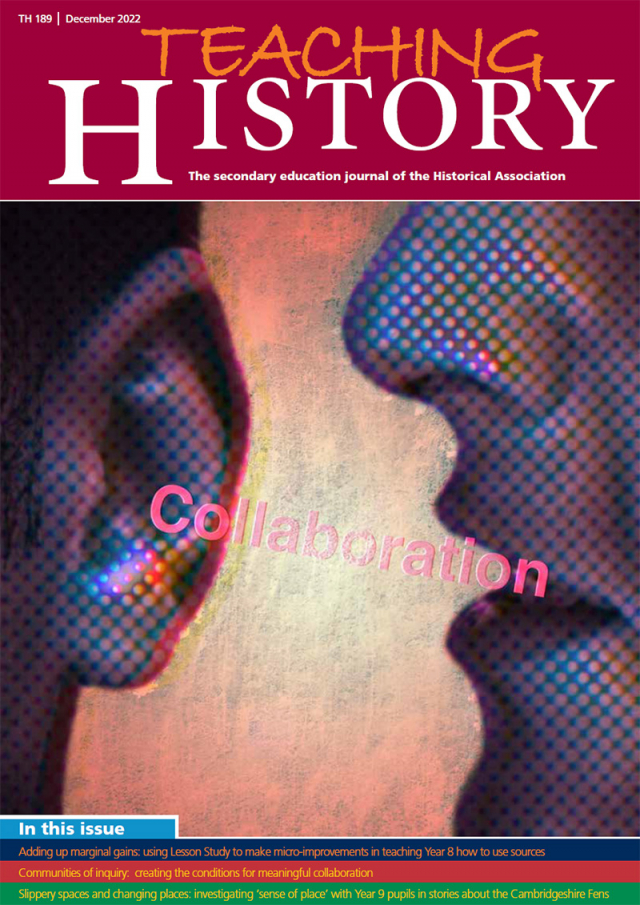Teaching History 189: Out now
The HA's journal for secondary history teachers

Editorial: Collaboration
Read Teaching History 189: Collaboration
Teaching requires many kinds of knowledge, which has many different sources. One of those sources of knowledge is other professionals. But history teachers are not simply passive receivers of settled bodies of knowledge produced by others. As the pages of Teaching History attest, there is a long tradition of history teachers building collective knowledge through a sustained, coherent research tradition.1 Arguably it is the communal nature of the endeavour that gives this knowledge its power. For as Dewey argued, knowledge is made more general, and thus more useful, when it acquires common meaning. Such common meaning is made through a process of communication and shared activity, i.e. collaboration.2
While collaboration between history teachers and other professionals is not a recent development, the Covid-19 pandemic, in bringing about new ways of working, also saw new forms of collaboration flourish. Many of the articles in this edition represent the fruits of these efforts.
Two articles, one by Longair, Milligan and McKenna, the other by Bailey-Watson and Crouch, explore the conditions necessary for effective collaboration between history teachers and historians. The collaboration between Longair, Milligan and McKenna stemmed from their shared concern with decolonising the curriculum. Making the most of the opportunities for flexibility afforded by online working, they reflect on the value of the knowledge the teacher participants acquired, and its practical effects on their planning and teaching. Bailey-Watson and Crouch sought a different kind of collaboration between teachers and historians. Working with PGCE trainees and PhD students, both at an early stage of their professional careers, they sought to create a collaboration in which both groups were equal partners, and the knowledge brought by both was viewed as being of equal value. They set out how they created a community in which such a collaboration could flourish and they offer some tentative conclusions about how the knowledge of both trainees and PhD students was changed.
The collaboration between Huijgen, Holthuis, Nijmeijer and van den Brand, a group of Dutch history education researchers and teachers, had multiple dimensions. Motivated by a desire to develop pupils’ citizenship education, they worked with the family of Rosie Glaser, a Dutch Holocaust survivor, to share her life and actions, and the decisions and dilemmas she faced. In developing an educational platform to make classroom resources available to teachers in the Netherlands, UK and Germany, they created further opportunities for collaboration: between teachers and students in different countries, and between students and Rosie Glaser’s nephew, whose account formed the basis of their teaching materials. Lucien Grillet, a history teacher working in Normandy, France, also sought to broaden his pupils’ perspectives by creating opportunities for them to work collaboratively with others. By working with outside organisations, he was able to bring his students together with survivors of the Second World War. Students drew on their encounters with veterans and résistants to make their own contributions to public knowledge of the war, publishing survivors’ accounts and creating a public ceremony of commemoration.
Tony McConnell and Joshua Mellor explore how their practice was enriched through collaborations with teachers and scholars from outside the subject discipline. McConnell offers an account of his school’s involvement in Lesson Study – an approach to collaboration in which a small group of teachers meet regularly to focus on a precise aspect of their pedagogical practice through a process of observation and joint planning. The article explores how Lesson Study aims to transcend the limitations of conventional forms of teacher collaboration by breaking down barriers between observer and observee and creating an ethic of collaboration, something for which all participants share responsibility. Mellor, in seeking to define what might be meant by a ‘sense of place’, looked beyond the subject discipline for answers. Drawing on the work of environmental historians, geographers and geography educators, he sought to explore how ideas about ‘sense of place’ surfaced in his pupils’ writing in a study of change in the Cambridgeshire Fens. Reflecting on his pupils’ achievements and the challenges they faced, he tentatively theorises two different purposes for which history teachers might explore ‘sense of place’ in the history classroom.
References
1. Counsell, C. (2011) ‘History teachers as curriculum makers: professional problem-solving in secondary school history education in England’ in B. Schullerqvist (ed.) Patterns of Research in Civics, History, Geography and Religious Education, Karlstad: Karlstad University Press.
2. Bleazby, J. (2012) Social Reconstruction Learning: dualism, Dewey and philosophy in schools, New York, Routledge.

